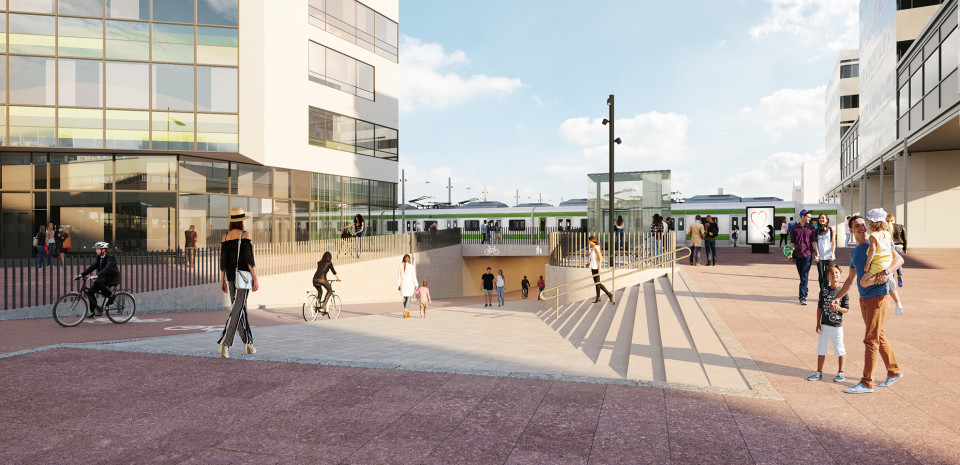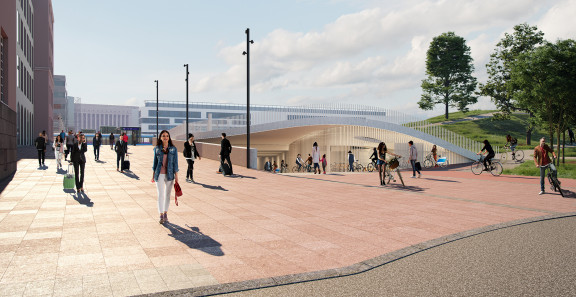A fast and safe cycle route will be built under Helsinki Railway Square over the next few years. Sitowise handled the general and architectural design for the underpass, which will connect Kaisaniemi and Kansalaistori Square. 5,000–10,000 cyclists and a similar number of pedestrians will use the completed tunnel every day.
The tunnel will create a brand-new pedestrian and cycle route between Kaisaniemi and Kansalaistori Square under Helsinki Railway Square. Thanks to the approximately 200-metre-long tunnel, cyclists will no longer need to watch out for busy cross traffic between the railway station and the city centre.
“The new underpass is the missing piece in Helsinki’s downtown cycle routes and will boost development in the Töölö Bay area, ” says Olli-Pekka Aalto, Project Director, Urban Environment and Land Use, City of Helsinki.
The new underpass will boost development throughout the entire Töölö Bay area.
-Olli-Pekka Aalto, Project Director, Urban Environment and Land Use, City of Helsinki
Spiral ramp replaced by a safer solution
The design process, which lasted almost ten years, was launched in 2010 with a construction feasibility study. Sitowise’s experts studied a variety of options for crossing the rail yard, both above and below. Crossing above the trains would have required a tall bridge that would have overly dominated the city skyline.
“We decided to draw up a general design for a cycle tunnel to be built underneath the tracks below the groundwater line,” says Sitowise’s Project Manager, Pekka Mantere. The tunnel will therefore require completely watertight structures, which will also have to be relatively thick due to the trains running overhead.
The tunnel’s entry ramps were also carefully considered. A spiral ramp was initially planned for Kansalaistori Square, but the city council wanted to look into a safer alternative.
“By working with cycling experts, we found a slightly steeper but safer straight ramp solution that also works well with its surroundings – now you just glide straight into the tunnel from the street,” says Sitowise’s Kirsi Rantama, Head of Department, Urban Design.
Aalto says that the greatest success achieved during the design phase has been getting general approval. Both citizens and politicians are now behind the project.
“We were able to reconcile a great number of preconditions – of which there were plenty, as the tunnel is located at a transport node surrounded by landmark buildings.”
Entrance architecture suits the surrounding cityscape
The tunnel entrances are located in highly visible spots: one is in Kansalaistori Square near the Oodi library and Parliament House, while the other is in Finland’s oldest city park, Kaisaniemi Park. “The entrances needed understated solutions that would not compete with the area’s existing architecture,” says Aalto.

The architectural design took the two different locations into account, while also creating a connection between the entrances through material choices and formal language. In Kaisaniemi, the underpass is accessed from under a leaf-shaped concrete canopy whose green roof blends into the park’s grassy hills.
“Rather than closing the area off, the canopy actually opens up the views in different directions,” says Architect Osma Lindroos from Lindroos Architects Oy, who designed the entrances with Sitowise. The green roof extends into a simple concrete railing, like a tree branch. A skylight provides the tunnel with natural light.
The entrance in the more urban setting of Kansalaistori Square also creates a background element for the rest of the cityscape. “The entrance is not covered. Instead, a semicircular wall guides cyclists and pedestrians towards the tunnel and platforms,” says Lindroos. The elevator shaft that rises up from street level has a transparent glass structure. “In this way, the elevator shaft will not obscure the view across Helsinki Railway Square.”
In the spring, Sitowise prepared the building permit drawings and revised the project’s cost estimate to EUR 26 million. Construction of the tunnel, along with a connected underground bike park, is scheduled to begin in November.
“The goal is to adapt to the growing number of cyclists in downtown Helsinki well in advance, not just to current numbers,” says Aalto. “The area is already trafficked by about 5,000–10,000 cyclists per day and at least as many pedestrians.”
